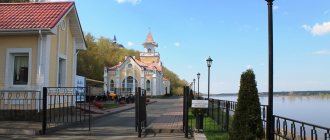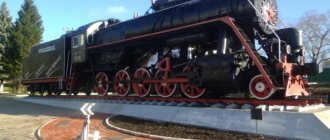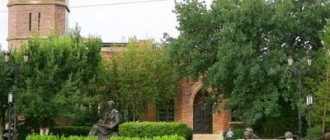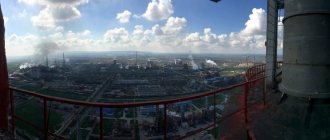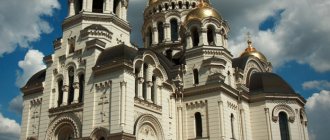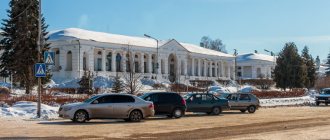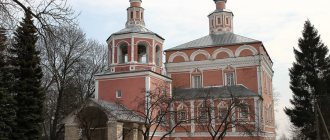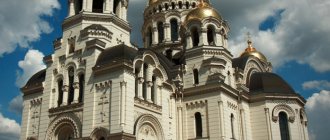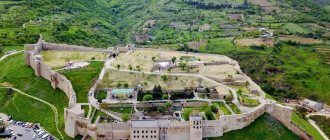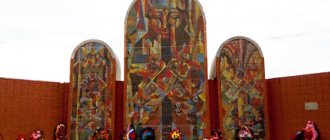The island-city of Sviyazhsk, as if emerging from Russian epics in our time, is located in the Republic of Tatarstan near the mouth of the Sviyaga River and 30 kilometers from Kazan in the upper Volga. The appearance on this small island of an ancient architectural complex is inextricably linked with the name of Ivan the Terrible, who looked for a place on the banks of the Sviyaga to build a fortress with the goal of capturing Kazan. To do this, near the city of Myshkin in 1551, the entire fortress was cut down and, numbered, sent here along the Volga. This is how a fortress town grew up on Mount Bald. Many of the sights of Sviyazhsk arose during the time of Tsar Ivan Vasilyevich and today amaze with their beauty against the backdrop of picturesque nature. Thousands of tourists come every year to see the unique historical and architectural complex and to be spiritually enriched. It is possible that the photos with names and descriptions given in the article will make you want to visit this amazing island city.
Sviyazhsk River Station
The best way to travel to the island of Sviyazhsk is by boat along the river, enjoying the views of the luxurious nature of the Volga region. Mooring to the island near the river station, you will immediately find yourself in the atmosphere of antiquity. The station building, where little has changed since the 19th century, will evoke the pages of Alexander Ostrovsky’s dramas or the movie “Cruel Romance” and will set you up to be in another era, with its inherent spiritual values.
The fate of the royal gift
By the 18th century, the island town of Sviyazhsk was experiencing a period of prosperity. It was especially crowded here on the days of great church holidays, as well as during fairs - merchants brought their goods here along the Volga. The fame of Sviyazhsk resounded like the bells of many Orthodox churches, under the walls of which lay a settlement, a market place with countless merchant shops and storehouses, as well as craft workshops. On the picturesque shore there was a guest house, where there were customs and guest houses and barns. Trade played an important role in the life of the island city - there were more than two hundred and fifty shops here alone. Among the artisans who lived in the settlement there were many furriers, shoemakers and canvas makers, as well as blacksmiths, potters, carpenters and mitten makers. A special niche was occupied by “food makers” - kalachniks, kiselniks, kvassniks, pirozhniki.
It is no coincidence that Mother Empress Catherine the Great, who visited Kazan in May 1767, having arrived along the Volga on the Tver galley, personally wished to see the island-city of Sviyazhsk.
They say that the local merchants gave the empress a luxurious reception, lining the road from the pier to the Assumption Cathedral with Persian carpets. Such a welcoming gesture touched the empress, and she gave the Sviyazhsk people her gilded carriage. The same one that is now kept in the Kazan museum. They took it there supposedly for restoration, but for some reason they forgot to return it. For which many Sviyazhsk residents were very offended by the Kazan residents: it was no good, they say, to take away a royal gift...
At the end of the 18th century, Sviyazhsk acquired the status of a county town and, as expected, its own coat of arms. The coat of arms of Sviyazhsk cannot be confused with any other. On it, against the azure background of the shield, a city and five fish are depicted floating on golden boats. The boats remind us that the first fortress was built from trees rafted from the upper reaches of the Volga. And the fish are about the fishery that has long fed the Sviyazhians. It’s not for nothing that in the old days they were called breamers...
At the end of the 18th century, Sviyazhsk acquired the status of a county town and, as expected, its own coat of arms. Photo: wikiwand.com
John the Baptist Monastery
The monastery was founded in 1551 for women who decided to devote themselves to serving God. The fire of 1795 destroyed almost all the monastery buildings. Then the monastery of nuns was transferred to the closed Trinity-Sergius Monastery, where they remained until the revolutionary events of 1917. Today, the St. John the Baptist Monastery has again become a monastery for men. The monastic architectural complex has survived to this day in good condition, and includes churches and buildings inherited from the Trinity-Sergius Monastery and buildings of the 19-20 centuries. There is an architectural and art museum on the territory of the temple complex.
Trinity Church
The oldest temple on the island and the main place of pilgrimage is the Trinity Church, which was built at the same time as the foundation of the fortress in 1551. A wooden church, erected without a single nail, has stood for more than 460 years. Tsar Ivan the Terrible himself attended services there more than once and sent prayers there. The interior of the church is decorated with a carved iconostasis and wooden images of saints. The ancient icons inside the temple give a special divine atmosphere, to which pilgrims from all over Russia seek to offer prayers to God.
Sergievskaya Church
One of the architectural pearls of Sviyazhsk, the Church of St. Sergius of Radonezh, was built in 1604 by order of Tsar Boris Fedorovich. The material for the construction of this single-domed refectory church was white limestone. The temple is distinguished by its laconic decor, characteristic of Pskov church architecture. The outer wall of the porch is decorated with an ancient fresco depicting the Trinity from the Old Testament. According to art historians, the surviving fresco is an enlarged copy of Andrei Rublev’s “Trinity”.
Cathedral in the name of the icon of the Mother of God “Joy of All Who Sorrow”
The cathedral, 32 meters high, built in 1898-1906, is the most grandiose church building in the monastery architectural ensemble. The multi-domed church is lined with red brick in the Russian-Byzantine style. The main spherical dome is surrounded at the bottom by a ring of 16 windows. The three entrances to the cathedral are distinguished by the architecture of portals with openings in the form of arches. The church walls are decorated with pilasters, niches, cornices and friezes at different levels. The interior walls were painted in 1914 with biblical scenes.
Chapel in the Name of the Royal Martyrs
Another attraction of the monastery is the single-domed chapel, built of brick in neo-Byzantine architecture in 1897 near the north-eastern fence of the monastery. It was restored in 2004 and consecrated in honor of Nicholas and Alexandra, the Royal Passion-Bearers who died at the hands of the Bolsheviks. At the entrance to the chapel, visitors stop to bow to an icon depicting the royal family. The chapel has ancient icons that sometimes stream myrrh.
Trinity Church
Trinity Church is the oldest building in Sviyazhsk. This wooden structure was made without a single nail. Construction was carried out under the leadership of the first Russian military engineer, clerk Ivan Vyrodkov. It is to him that historians attribute the idea of building Sviyazhsk. The fortress was cut down many kilometers from the site of construction, in the city of Myshkin. Then all the logs were numbered and secretly transported to the banks of Sviyaga. In a matter of days, powerful fortifications were erected 30 kilometers from the then enemy Kazan, which played a huge role in its capture by Russian troops in 1552.
The carved iconostasis, wooden images of saints, and ancient icons give the temple a discreet coziness, and the knowledge that Ivan the Terrible himself could communicate with higher powers here makes the temple one of the most attractive places in Sviyazhsk.
Location: Troitskaya street - 3.
Mother of God Assumption Monastery
The Assumption Monastery of the Mother of God, founded in 1555, is the oldest and richest Orthodox monastery in Tatarstan and the Volga region. Masterpieces of ancient Russian architecture located on the monastery territory are the bell tower of the Church of St. Nicholas the Wonderworker and the Assumption Cathedral. Also in the monastery complex there are buildings from the 17th century - a two-story archimandrite building, reminiscent of a Russian tower, fraternal buildings and churches in honor of Saints Mitrofan of Voronezh and Herman of Kazan.
Assumption Cathedral
The majestic Cathedral of the Assumption of the Blessed Virgin Mary belongs to the authorship of the famous Russian architect Postnik Yakovlev-Brama, who built the Moscow St. Basil's Cathedral. Tourists and believers are amazed by the extensive fragments of fresco painting from 1561, preserved on an area of 1080 square meters. They depict scenes from the Bible, Gospel and apocryphal legends in the manner of Western European church painting. Under the dome of the cathedral you have the opportunity to see an icon depicting St. Christopher with the head of a horse and a unique fresco depicting Ivan the Terrible. The “Ukrainian Baroque” appearance in which the temple appears today was given to it in the 18th century. Then the cathedral, crowned with a new dome, grew due to the addition of 12 kokoshniks.
Church of St. Nicholas the Wonderworker
The building of the St. Nicholas Refectory Church, erected in 1555-1556, became the first stone structure of this type of religious architecture in the entire Volga region. The three-altar church building, modeled on the church-bell tower, was built by Pskov masons and reflected the architectural details characteristic of Pskov churches. Inside the temple there are remains of a fresco depicting the face of St. Nicholas of Mozhaisk. The church-bell tower of St. Nicholas the Wonderworker majestically rises 43 meters above Sviyazhsk and serves as a landmark on the way to the Assumption Monastery.
St. Nicholas Church
The Church of St. Nicholas the Wonderworker is the first stone refectory church and was built in 1555-1556. The author of the project is unknown, but there is evidence that the Pskov artel of masons Ivan Shirai took part in the construction of the temple, which, obviously, introduced into its architectural appearance elements characteristic of the church complexes of Pskov.
The height of the building and the laconicism of the facade make it dominant both in the Assumption Monastery complex and in the architecture of the entire city.
Location: Nikolskaya street.
Church of Constantine and Helena
The construction of the Church of Constantine and Helena and its bell tower for the lay inhabitants of the settlement dates back to the end of the 17th century. At the beginning of the 18th century, the church and the separate bell tower were combined into a refectory. Later, the temple was added with two boundaries. The erected stone church turned out to be elegant thanks to the Baroque style decor. Having served parishioners until the 20s of the last century, it was closed until the 90s. After restoration, the church opened to parishioners, pilgrims and tourists. It contains church shrines - icons of the Mother of God, St. Sergius of Radonezh, St. Herman of Kazan with parts of his relics.
Monastery school building
Behind the St. Nicholas Church there is a small two-story building, which at the beginning of the 19th century housed a monastery school, and in Soviet times, here, as in the bishop’s building, the wards of a mental hospital were located. The building was built at the end of the 17th - beginning of the 18th century, but despite the fact that it is already more than 300 years old, it is still quite durable, and after restoration it looks like new.
Monastic school
Walking around the territory of the Assumption Monastery, one cannot help but notice the snow-white Brotherhood building stretched along the wall.
Cannon "Devka's head"
Sviyazhsk, created as a fortress, had the latest weapons for that time - cannons. Each of them was different from the other, had its own name and stood in different places of the fortification. The city's Nativity Gate was defended by the Devkin's Head cannon. She got her name thanks to the image on her gun carriage of a female head, similar to the Gorgon Medusa. The cannon installed in front of the local history museum is a copy, created according to drawings found in ancient chronicles.
Chapel in the Name of the Royal Martyrs
A landmark of Sviyazhsk, built in our time, is the chapel in the Name of the Royal Passion-Bearers, consecrated in 2004. It is dedicated to the family of the last Russian emperor, who suffered martyrdom at the hands of the Bolshevik government. At the entrance to the temple there is an icon depicting the royal family. There are many ancient icons in the chapel, some of which stream myrrh from time to time.
Museum of the History of Sviyazhsk
The Sviyazhsk Historical Museum occupies four government buildings dating back to the first half of the 19th century and united into an integral complex. Reviews from museum visitors indicate that the exhibits, which recreate history through interactive exhibits and panoramas, are impressive. The electronic map shows all excursion routes around Sviyazhsk, by activating which tourists receive a lot of interesting information.
Abbot's corps
In the very corner of the monastery there is a small two-story building of the Abbot's building; in some sources it is also called the Bishop's building. This building was built in the second half of the 17th century and looks very similar to the tower from Russian fairy tales. It is believed that nowhere else in Kazan and its surroundings not a single residential building built in the 17th century has survived - there are churches, but there are no more residential buildings. So the Rector’s building of the Assumption Monastery in Sviyazhsk is a unique architectural monument in its own way. By the way, we saw a similar building in Kostroma when we visited the Ipatiev Monastery.
Abbot's corps of the Assumption Monastery
Bishop's Corps of the Assumption Monastery
During Soviet times, the Rector's building housed the wards of a psychiatric hospital. A little further we will see St. Nicholas Church, which amazes with its power and beauty.
Monument to the victims of Stalin's repressions
After the revolution, Sviyazhsk was used for repression of political prisoners, kept in small monastic cells of up to 18 people. It became a place of executions and torture, as evidenced by the many graves scattered around the island. The monument to the victims of Stalin's repressions reminds us of these tragic times, evoking a feeling of deep compassion. It depicts a block of stone with a prison grate carved into it, through which the hand of a prisoner stuck through with a bird in his hand, symbolizing freedom. The monument stands near the entrance to the island on the side where the dam stands.
How to get there
One of the main attractions of Tatarstan is located in the Zelenodolsk region of the republic, 29 km southwest of Kazan.
By bus.
On Saturdays and Sundays, the bus from Kazan to Sviyazhsk leaves at 8:40. A ticket costs 150 rubles one way.
Monument to the Victims of Political Repression
By rail.
There are 10 trains a day running from the Kazan-Pasazhirskaya station to the Sviyazhsk railway station. The journey takes 1 hour 15 minutes. From the train station the island is easily accessible by buses and taxis.
By water transport.
In summer, motor ships run daily from the River Port of Kazan to Sviyazhsk. The journey by water lasts 2 hours.
Children's
By car.
The distance from Kazan to the city-island by road is 58 km. Tourists leave the city along the M7 highway towards Moscow, and after Isakovo they turn right towards Sviyazhsk.
Attraction rating
Rating 3.33 [3 vote(s)]
| ← RUSSIA | REPUBLIC OF TATARSTAN | EUROPE → |
"Lazy Torzhok"
You can feel the whole atmosphere of past centuries by visiting the historical reconstruction complex “Lazy Torzhok”, located on Rozhdestvenskaya Square. Here, numerous souvenir shops offer products created by the hands of local craftsmen. On weekends, the square becomes the site of a reenactment of battles between the Tatars and Russians that took place in the 16th century. Those interested can try on the combat armor of warriors and shoot with ancient weapons. There is also the tavern “U Ivana”, where you can try dishes prepared according to medieval recipes.
Horse yard
Leaving the Lazy Torzhok, take a look at the territory of the horse yard, recognized by tourists as the highlight of Sviyazhsk.
Here you will experience the pleasure of seeing beautiful thoroughbred horses, and enjoy riding in a phaeton and on horseback. You are allowed to feed the beautiful horses and take pictures with them as a souvenir. On the horse yard there is a “Crafts Settlement”, where it is interesting to take part in master classes of potters and blacksmiths, learn how to sew leather goods, master the skills of weaving objects from birch bark or painting clay toys. Crafts Settlement is open from Friday to Sunday. The island's attractions include its amazing natural landscapes, which served as inspiration for painters of different centuries. The view of the island washed by the waters of the river, combined with the grandeur of the temples and the original architecture of civil buildings, will not leave any Russian person indifferent. Since 2007, the island has been connected to the mainland by an eight-kilometer causeway. Now you can get to this wonderful corner of Russian land not only by boat, but also by car.
The origins of the city-city of Sviyazhsk
The history of the creation of the city is connected with the development of this region by the Russians, or more precisely with the conquest and annexation of the Kazan Khanate to the Russian state.
In the 15th century, in this place there stood a cone-shaped hill overgrown with centuries-old forest - Mount Kruglaya, surrounded by the rivers Shchuka and Sviyaga. And already in the middle of the 16th century there was a powerful fortress of the Russian Tsar Ivan the Terrible
, which grew up on enemy soil like a fairy-tale city, at the behest of a pike...
Beginning in 1547, Ivan the Terrible undertook systematic campaigns against Kazan
, but they were all unsuccessful. It was clear that without creating a strong support base near Kazan, it was impossible to capture the city. Returning from another unsuccessful campaign in 1550, the young Tsar Ivan drew attention to the ideal military-strategic location of Mount Kruglaya and decided to build a Russian fortress here. But how can it be built unnoticed by the enemy, who is only 30 km away? An ingenious plan was developed: to cut down a city on “Russian soil” in the upper reaches of the Volga and then lower the marked logs along the water and assemble them on the spot, saving time and effort.
As they say, no sooner said than done. During the winter of 1550-51, walls, towers, huts and even churches were cut down in the Uglek forests. And in the spring, after the opening of the rivers, logs for the future fortress began to be rafted along the Volga and further along Sviyaga. To distract the Kazan residents, Russian troops captured all crossings on the main rivers, and detachments under the command of Prince Serebryany
attacked the residents of Kazan Posad.
The construction of the fortress city of Sviyazhsk was unprecedented at that time - a gigantic amount of work was carried out in one month: the territory was laid out, the forest was cut down, ditches were dug, log buildings were assembled, and the fortress walls were covered with earth and stone. A first-class Russian fortress with eighteen towers, seven of which were travel towers, numerous buildings for housing military forces, as well as the Trinity Cathedral
and
the Church of the Nativity
. The tallest tower was Rozhdestvenskaya with the main entrance gate and a lifting lattice. It housed a guardhouse and an archery with two prisons. The ringing of a large self-breaking clock with a bell announced the changing of the guard.
During the construction of the fortress, the local population was attracted to the side of the Russians: Chuvash, Mari, Mordovians, which provided a reliable rear. Ivan the Terrible named the fortress city Sviyazhsk.
Very soon the new city became not only a military fortress, but also a trade and administrative center in which artisans and traders willingly settled. Already at the beginning of 1552 it was a rich and lively city, with numerous merchants selling livestock and a variety of goods. And 15 years later, Sviyazhsk was already a real city with a fortress (kremlin), posad (prison) and settlements. In the fortress there was the Sovereign's courtyard with artillery and food warehouses
, 2 monasteries, 6 churches, a clerk's hut, etc. Here lived: princes, boyars, military men, clergy, artisans and merchants. There were 6 streets throughout the city, there were 370 houses and 4 shops. The fort had 736 residential buildings, a market with a living room, customs officers, a brewery and a bakery. Residents of settlements were mainly engaged in agriculture.
Capture of Kazan by Ivan the Terrible
It should be noted that the city was not built spontaneously, but according to a specific plan. The main street from Rozhdestvenskie to Nikolomozhaiskie gates divided the city into two halves, and the streets coming from all other entrances to the city merged into it. The central square was located on both sides of the Rozhdestvensky central entrance. On the side of the fortress there were artillery and granary courtyards. The side facing the landing consisted of a guest courtyard and shopping arcades that went down to the pier on the Sviyaga River.
